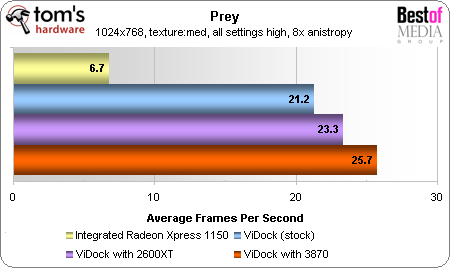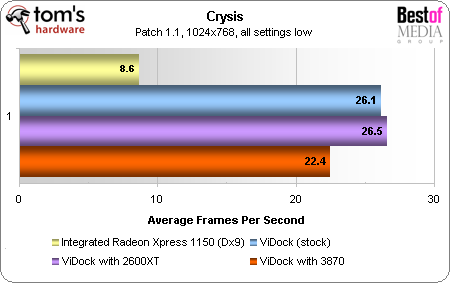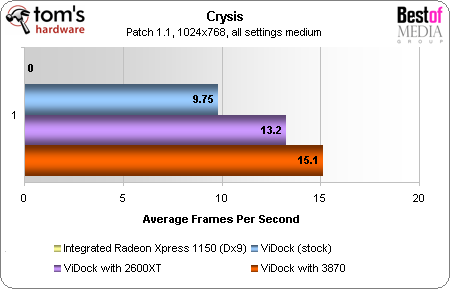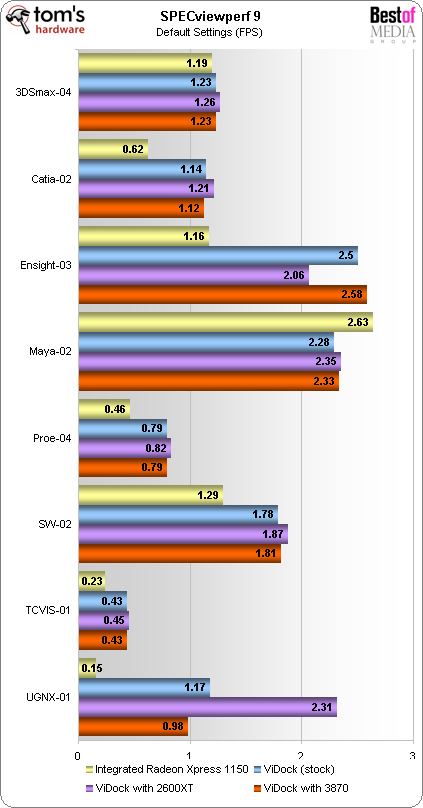External Graphics Upgrade for Notebooks
Modifying the ViDock for use with other graphics cards: the Radeon 2600 XT and 3870
Without faster graphics cards to test through the ViDock’s ExpressCard interface, it’s difficult to judge exactly how much of an impact the slower bus has on performance. To that end, let’s see if we can do a few modifications and help the ViDock accommodate some faster video cards. (Of course, this sort of thing will almost certainly void your warranty, so it’s not something we’d recommend by any stretch of the imagination.)
With the ViDock open, it’s easy to imagine taking out the stock Radeon 2600 PRO and substituting a more powerful video card. The cards we chose to put in the ViDock would have to be Radeons to work with the driver, so we chose a Sapphire 2600 XT and an HIS 3870 to work with.
The 2600 XT was quite easy to integrate into the ViDock chassis. The large silent heat sink was a bit too large to fit in the enclosure, but we simply ran it with the enclosure off of the unit. Since the 2600XT doesn’t require a separate power connector, it was that simple.
The Radeon 3870 was another kettle of fish entirely, though. The large card interfered with some of the parts on the ViDock chassis that had to be temporarily removed. In addition, the 3870 requires its own dedicated power cable; to get the card to work, we had to hotwire a separate power supply to provide the 3870 with the juice it needed to run. This was not a very practical solution for real use, but we figured it would get us through the benchmarks.
After we got things going, we recorded the following data.

3dMark shows us the ExpressCard bandwidth bottleneck as clear as day. The Radeon 3870 should be getting scores many times that of the 2600 PRO in the stock ViDock, but instead we saw only a subtle increase in performance. The 2600 PRO is looking like a good match for the slow ExpressCard bus.

Prey shows us a close representation of what 3dMark just displayed: the ExpressCard bus is limiting the faster video cards so that they perform very close to the 2600 PRO that comes with the ViDock Pro.
Get Tom's Hardware's best news and in-depth reviews, straight to your inbox.

At low settings, Crysis shows us a curious drop in performance for the Radeon 3870 compared to its slower 2600 brethren. This puzzling scenario defies explanation.

At the shader intensive medium settings, the 3870 takes its rightful place at the head of the pack. But it’s important to note that the 3870 can’t even muster enough power to play Crysis at medium settings at 1024x768, again because of the ExpressCard bus’s relatively low bandwidth.

Professional 3D applications show us more of the same story: the ExpressCard bus severely limits the performance of the Radeon 2600 XT and 3870. It’s no wonder that ViDock offers the Radeon 2600 PRO in the fastest ViDock model, as anything more is a waste of money and would just require more power to run.
Current page: Modifying the ViDock for use with other graphics cards: the Radeon 2600 XT and 3870
Prev Page 3D Application and HD Video Playback Benchmarks Next Page OverclockingDon Woligroski was a former senior hardware editor for Tom's Hardware. He has covered a wide range of PC hardware topics, including CPUs, GPUs, system building, and emerging technologies.